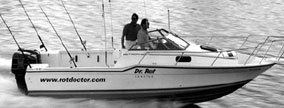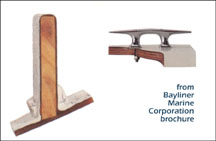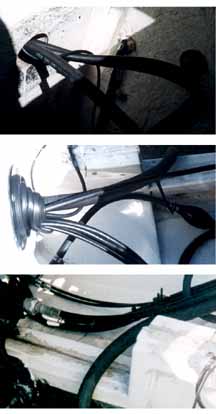Home > Fiberglass Boats- Maintenance
Fiberglass Boats
Most fiberglass boats have wood in them. This is particularly true with power boats, where engine torque and high speeds require substantial rigidity and impact resistance. Sailboats travel more slowly and depend more on hull structure for strength, but even so they often have glass-encapsulated wood stringers, engine beds, and lots of balsa or plywood cored decks. This wood will rot.
The problem starts when water gets to the wood, and then with enough heat the rot fungi get a grip and off they go. There are certain bacteria that eat the wood as well.
You can’t keep the water away from the wood. Eventually it will get there. The boat builders are no help: they lay down the wood grids, chopper-glass them for protection and some strength, and then proceed to drill limber holes, fuel tubing holes, electrical wiring holes and what-not right through the glass and wood. The result? The wood is no longer protected, water gets in, and then comes the rot.
A few manufacturers treat the wood to help prevent the rot, but most don’t, and certainly the large volume manufacturers do not. We ship a lot of specialized epoxy products to treat the rot and restore substance and strength and we know to which boats these products are being applied. But we’re not going to mention any names — except one, and that’s because we bought a 10 year old model for testing and product evaluation.

Above is a picture of a 23′ Bayliner Trophy 2302 Walk-around built in 1990. Ours has a 200 hp Merc outboard that pushes it to about 40 mph wide open. We like the way it rides and handles choppy water. It cruises nicely at 30 mph, assuming reasonably smooth water. It had been well cared for by the original owner and we were unable to find any bad wood or broken fiberglass. It is stored on a trailer and loosely covered with a tarp. Eventually we’ll have it under a hard cover, where we’ll leave it open for ventilation. We leave transom and cabin hatches open during storage so the air can move around and the moisture can evaporate away. The strategy — and it should be your strategy as well — is to keep environmental conditions around the boat in a state of change and flux, to keep the moisture away, to keep the sun off the boat, and to keep the rot fungi unhappy about their little lives.
On our boat there is glass covered wood everywhere. The top left drawing (from Bayliner’s brochure) shows a stringer chopper-glassed into place and a cleat backed with wood. And of course there’s the transom—the first photo is of a stern side wall that has been drilled through for fuel hoses (NOTE: click on any of the pictures on the left for a closer look). You can see the wood core, waiting to get good and wet and warm and start rotting away. The second photo down shows the main fuel access port with a rubber gasket. In the next photo you can see the top of the transom and where it’s been gooped over with compound. The original owner was trying to keep the water out, because if it gets down into that wood transom core there will eventually be rot and big trouble ahead. Below are pictures of a bow clamp that shows old, funny-looking bedding compound and a stanchion base with no indication that there is any bedding compound there at all. There’s wood under that stanchion base.

The upshot of all this is that we’re going to have to treat all the exposed wood we can find with CPES™ (Clear Penetrating Epoxy Sealer) for rot protection, pull all the fittings and treat the wood underneath and bed or re-bed with compound, pull all the goop off the transom seam and CPES-treat (soak, actually) all the wood inside the transom. If there are pockets of rot that we don’t know about the CPES™ will get there and stabilize and harden the wood. CPES™ goes where the water goes, and if the wood is reasonably dry then the CPES™ is absorbed and the wood is hard again and highly rot-resistant. How do we know this? Because we’ve been using CPES™ for years on wood boats and once the wood has been treated, we’ve never seen rot reappear. We’ll get into the rules for CPES™ treatment a bit later so that you can consider it for use on your boat.
Plywood is often used in fiberglass boat repairs. We suggest that you click here to see the results of our testing on plywood panels.
We recently talked with a guy who was ordering CPES, Layup & Laminating Resin™ and Fill-It™ Epoxy Filler to restore his glass boat. He said that he’d learned a lot of valuable lessons by repairing the boat, not the least of which was that if he ever gathered enough cash together to buy a new boat he would spend a couple of weeks of pre-launch protection treatment with CPES™ and compound before the boat ever saw the water. It’s something you might want to think about.
The manufacturers could protect the wood, but it would take time and money and they know that for most people price is a major issue. The average person who buys a new boat knows that by the time the trouble starts he’ll probably have moved on, if he even thinks of it at all. It’s the guys who buy used who inherit the problems. Welcome to the world of used glass boats!
General Rules for Glass Boat Maintenance
Here are some very general rules for glass boat maintenance that are not usually covered in the owner’s manual:
-
Cover loosely so air can circulate. Use a light color cover so that minimum heat is absorbed. The tight-fitting canvas covers look nice but they allow little air circulation, even with the little ventilation pockets.
-
Keep hatches, lockers etc. open if possible so air can circulate. This evaporates away moisture and allows for more normal temperature gradients.
-
Always keep the bilges as dry as possible. On trailered boats be sure to pull the drain plug and have the stern be the lowest part of the boat when you haul out.
-
Examine the boat interior structure carefully and search for areas where wood has been exposed. When you find it, treat thoroughly with CPES™ (Clear Penetrating Epoxy Sealer), allowing the wood to absorb all it can.
-
Examine all through-hull and through-deck fittings and make sure they are properly bedded. Re-bed if questionable. Do not use silicone bedding compounds! We don’t like them and neither do most professional boat people. Use instead a polysulfide or polyurethane compound. We prefer the polyurethanes, such as 3M’s 4200 because we believe the urethane bonds better with epoxy than the polysulfide’s. After applying the compound, fasten down 75% of the way, allow the compound to cure, and then fasten down to tight. This makes the compound into a kind of o-ring seal — much better for keeping water out.
-
Examine the hull exterior and look for places where the glass has been chipped or scratched to the laminate. If you find them, dry thoroughly (maybe a hair dryer?) and then treat with CPES™. The CPES™ will penetrate further through the glass substrate than any other epoxy product we know of. Treat at least 3 times, allowing 24 hours between treatments. Allow the glass to absorb all the CPES™ it will. After the final treatment allow a few days of cure time and then apply our Fill-It™ Epoxy Filler to smooth off. Paint the area for final finish. Be careful of gel coat over epoxy. Remember that polyester resins do not adhere well to epoxy, unless the epoxy is free of amine blush and is a bit rough. For small dings in the gel coat, CPES™ is not required and a standard gel coat repair kit can be used to finish.



